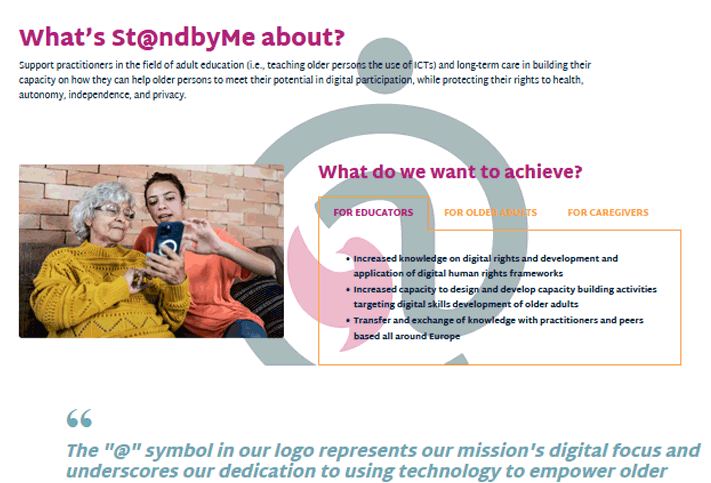
| Short descriptor of good practice |
| Support practitioners in the field of adult education (i.e., teaching older persons the use of ICTs) and long-term care in building their capacity on how they can help older persons to meet their potential in digital participation, while protecting their rights to health, autonomy, independence, and privacy. |
| Type of setting where good practice is delivered |
| Dedicated adult education centers or institutions focused on providing learning opportunities for adults. These centers offer a structured and formal environment for training practitioners, providing access to resources and facilities conducive to learning – Adult education centers, Long-term care facilities, Community centers or Online learning platforms. |
| Time Frame for delivery of good practice |
| Project Planning and Design (3-6 months), Curriculum and Training Material Development (2-4 months), Practitioner Recruitment and Qualification (1-2 months), Infrastructure Setup (2-3 months), Training Delivery and Community of Practice Building (6-12 months), Field Testing and Iterative Improvement (3-6 months), Knowledge Sharing and Advocacy (Ongoing) |
| Type of learner the best practice is supporting |
| Practitioners in Adult Education and Long-Term Care Description: This category includes professionals, educators, and caregivers involved in adult education and long-term care services for older persons. Role: These learners are the individuals responsible for facilitating the digital literacy training among older persons. They may include adult education instructors, long-term care professionals, social workers, and other practitioners. Older Persons (Seniors) Description: This category comprises older individuals who are the recipients of the digital literacy training. Role: These learners are older adults seeking to enhance their digital skills and participate more actively in the digital world. They may reside in long-term care facilities, community settings, or their own homes. |
| Resources used as part of good practice |
| Development of a comprehensive curriculum covering digital literacy, human rights frameworks, and effective teaching methodologies. Creation of educational materials, guides, and manuals for practitioners and older learners – Curriculum and educational Materials, Training modules and workshops, Practitioner training programs, Community of practice tools, Field testing protocols. |
| Aims and objectives of good practice |
| The aims and objectives of the good practice outlined in the project to support practitioners in adult education and long-term care for older persons in digital participation are multifaceted. They encompass empowering both practitioners and older individuals, promoting digital literacy, and upholding human rights. |
| Evidence as to why this was considered good practice |
| The practice gave a positive outcome for both practitioners and older learners. This included improved digital literacy skills, increased confidence in technology use, and a sense of empowerment among older individuals: · Impact on human rights · Community engagement · Inclusive design and accessibility · Adherence to ethical standards |
| 3 Key learning Principles that were used in this good practice to support senior learners |
| 1. Human rights framework 2. Field-testing and iterative improvement 3. Ethical use of technology |
| Any additional learning that we can take from this good practice example |
| Lots of resources, tips & tricks, examples of good practice are reachable on official web page of the project:https://www.standbymelearning.eu/ |
| Any Additional Information |
| / |
